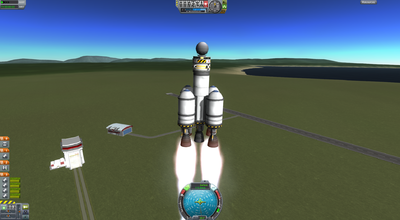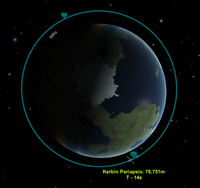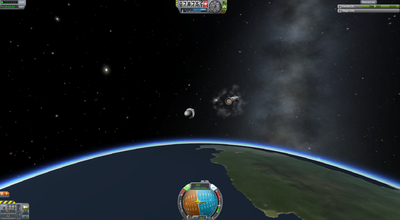Difference between revisions of "Tutorial: Sputnik 1"
(add details]) |
Peteletroll (talk | contribs) m (Spam removed) |
||
| Line 7: | Line 7: | ||
Welcome to the first entry of learning Kerbal Space Program through a re-enactment of historical key-missions of the spaceflight history of Earth. This tutorial assumes that you have completed the ingame tutorials so you know the basic controls. | Welcome to the first entry of learning Kerbal Space Program through a re-enactment of historical key-missions of the spaceflight history of Earth. This tutorial assumes that you have completed the ingame tutorials so you know the basic controls. | ||
| − | Our first complete mission will be a recreation of the launch of Sputnik, the first man-made object to enter Earth's orbit. The successful launch of Sputnik in 1957 by the Soviet Union was a shock to the | + | Our first complete mission will be a recreation of the launch of Sputnik, the first man-made object to enter Earth's orbit. The successful launch of Sputnik in 1957 by the Soviet Union was a shock to the whole world. While the space programs by different branches of the US military were mostly impressing with <s>explosions on launchpads</s> ''unplanned vehicular disassemblies'', nobody expected the Soviet Union to already be so far ahead in rocket science. The beeping sound of Sputniks transmitter - strong enough to be picked up by amateur radios all around the world - was a wake-up call for the West to finally start taking space exploration seriously. Now we are going to recreate this historic mission. |
| − | |||
We will launch a satellite into space and bring it to a stable orbit. Space - for our purpose - starts at an altitude of 100 km where the atmosphere doesn't affect objects anymore and thus allows them to enter an orbit which is stable for an indefinite amount of time. | We will launch a satellite into space and bring it to a stable orbit. Space - for our purpose - starts at an altitude of 100 km where the atmosphere doesn't affect objects anymore and thus allows them to enter an orbit which is stable for an indefinite amount of time. | ||
| Line 30: | Line 29: | ||
** 4x [[LV-T30 Liquid Fuel Engine]] | ** 4x [[LV-T30 Liquid Fuel Engine]] | ||
| − | We need to add a battery bank to the payload, because the Stayputnik command module requires energy to stay operational. During the ascent the engines will generate energy, but after orbit insertion it will have to work on its own energy reserves. By itself it can store 5 units of energy which keeps it operational for just over 2 minutes | + | We need to add a battery bank to the payload, because the Stayputnik command module requires energy to stay operational. During the ascent the engines will generate energy, but after orbit insertion it will have to work on its own energy reserves. By itself it can store 5 units of energy which keeps it operational for just over 2 minutes. Afterwards it just becomes debris. The Z-500 adds another 500 units of energy which is enough to keep it operational for several orbits. Using the Z-100 battery packs would be more mass-effective, but unfortunately they aren't as elegant to integrate into a rocket design. |
If you want your satellite to look more like the real Sputnik, you could also add four radially-mounted [[Communotron 16]] antennas to the round part of the Stayputnik so that they face backwards in a 45° angle, but keep in mind that they don't do anything but making the mission more difficult by adding additional mass and drag to your rocket. | If you want your satellite to look more like the real Sputnik, you could also add four radially-mounted [[Communotron 16]] antennas to the round part of the Stayputnik so that they face backwards in a 45° angle, but keep in mind that they don't do anything but making the mission more difficult by adding additional mass and drag to your rocket. | ||
| Line 39: | Line 38: | ||
[[File:Sputnik-liftoff.png|400px|The vessel just after ignition]] | [[File:Sputnik-liftoff.png|400px|The vessel just after ignition]] | ||
| − | Before you start your flight, switch on RCS and SAS so you have better control over your | + | Before you start your flight, switch on RCS and SAS so you have better control over your rocket. Also, switch your nav-ball from surface-mode to orbit-mode by clicking on the dial above it (it should read "Orbit 174.5m/s"). |
This phase is about getting out of the atmosphere as quickly as possible. The thick atmosphere around the ground creates drag which costs you fuel, so we will head straight up to get out of it. | This phase is about getting out of the atmosphere as quickly as possible. The thick atmosphere around the ground creates drag which costs you fuel, so we will head straight up to get out of it. | ||
Revision as of 08:56, 9 November 2015
This page or section is in need of being brought up to date. Please help Kerbal Space Program Wiki by fixing inaccurate or outdated information.
|
| “ | SPACE AGE IS HERE - Man-made moon is circling world — Daily Express |
” |
Welcome to the first entry of learning Kerbal Space Program through a re-enactment of historical key-missions of the spaceflight history of Earth. This tutorial assumes that you have completed the ingame tutorials so you know the basic controls.
Our first complete mission will be a recreation of the launch of Sputnik, the first man-made object to enter Earth's orbit. The successful launch of Sputnik in 1957 by the Soviet Union was a shock to the whole world. While the space programs by different branches of the US military were mostly impressing with explosions on launchpads unplanned vehicular disassemblies, nobody expected the Soviet Union to already be so far ahead in rocket science. The beeping sound of Sputniks transmitter - strong enough to be picked up by amateur radios all around the world - was a wake-up call for the West to finally start taking space exploration seriously. Now we are going to recreate this historic mission.
We will launch a satellite into space and bring it to a stable orbit. Space - for our purpose - starts at an altitude of 100 km where the atmosphere doesn't affect objects anymore and thus allows them to enter an orbit which is stable for an indefinite amount of time.
Contents
Ship design
For this mission we will recreate the Soviet R7 rocket. The first stage is made up of four engines which surround a second stage engine with the payload on top.
- Payload stage
- Second stage
- 1x TR-18A Stack Decoupler
- 1x FL-R25 RCS Fuel Tank
- 4x RV-105 RCS Thruster Block (symmetric radial-mounted)
- 1x FL-T800 Fuel Tank
- 1x LV-T30 Liquid Fuel Engine
- First stage
We need to add a battery bank to the payload, because the Stayputnik command module requires energy to stay operational. During the ascent the engines will generate energy, but after orbit insertion it will have to work on its own energy reserves. By itself it can store 5 units of energy which keeps it operational for just over 2 minutes. Afterwards it just becomes debris. The Z-500 adds another 500 units of energy which is enough to keep it operational for several orbits. Using the Z-100 battery packs would be more mass-effective, but unfortunately they aren't as elegant to integrate into a rocket design.
If you want your satellite to look more like the real Sputnik, you could also add four radially-mounted Communotron 16 antennas to the round part of the Stayputnik so that they face backwards in a 45° angle, but keep in mind that they don't do anything but making the mission more difficult by adding additional mass and drag to your rocket.
Mission phases
Lift-Off
Before you start your flight, switch on RCS and SAS so you have better control over your rocket. Also, switch your nav-ball from surface-mode to orbit-mode by clicking on the dial above it (it should read "Orbit 174.5m/s").
This phase is about getting out of the atmosphere as quickly as possible. The thick atmosphere around the ground creates drag which costs you fuel, so we will head straight up to get out of it. When you are ready, hold shift to set your throttle to maximum, and ignite your first stage by pressing space. Watch the nav-ball and keep your rocket pointed at the center for a perfectly vertical ascent. When the first stage has burnt all its fuel, drop it and ignite the second stage using space. Don't press space too often, or you will drop your payload.
Gravity-Turn
When you've reached an altitude of 12 km (should be soon after igniting the 2nd stage), air resistance becomes much less. Now we start to build up horizontal speed so we get fast enough to get into a stable orbit. Do this by tipping your rocket to the east, and keeping it at the 45% mark.
Getting into a circular orbit
Once your craft is at 90% east and stable, switch to the map view(orbital view) by pressing the button on your bottom left or by pressing the "m" key. Here you can see your flight path and your apoapsis. Switch on the nav-ball in map view by clicking on the gray arrow at the bottom of the screen. Now you can control your rocket and view it's trajectory path. Monitor your apoapsis, your goal now is to get it to 75-100 km.
Once your projected apoapsis reaches the range(75-100 km), cut the engine and let your craft drift towards your apoapsis. While you're waiting turn your craft all the way horizontal pointing east. When you reach your apoapsis, burn your remaining fuel to get into a circular orbit. Stay in the map view and your craft's path will make a complete circle around Kerbin. When that happens, make sure the orbit is what you want then cut the engine(if you still have fuel left), the longer you continue to give you engine fuel, the wider the orbit will be.
Should you run out of fuel, remember that you likely still have plenty of monopropellant left from the ascent. Press H to use it to accelerate forward. It doesn't do much, but it can be enough to give you the crucial last few m/s to get into a stable orbit.
Dropping the payload
After you are in orbit, drop your payload using space. Thanks to the powerful separator it will be blasted forward while the engine stage drifts behind. Congratulations, you just made space history. Go into time-warp and watch your satellite orbit Kerbin gracefully.
What next?
Unfortunately the satellite still has a limited lifetime due to energy use. To extend its life further it needs some kind of energy source in the form of photovoltaic panels or a Radioisotope generator. When you have a sustainable energy supply, you can also add some scientific payloads like accelerometer, barometer, thermometer or gravimeter. Note that all of this will increase weight and atmospheric drag, so you will need to add some more tanks to your rocket.
When unmanned satellites become boring, it's time to get to the next stage of space exploration: your first manned mission.





